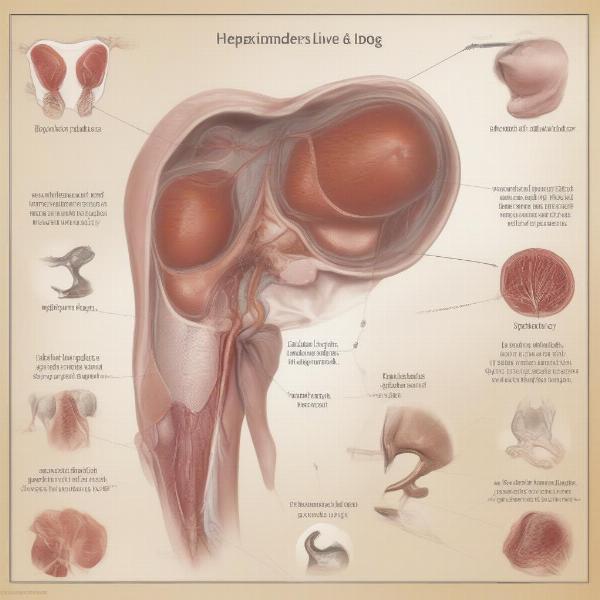The liver is a vital organ in a dog’s body, performing a multitude of essential functions that contribute to overall health and well-being. Understanding dog liver anatomy is crucial for recognizing potential health issues and providing appropriate care. This article will delve into the intricacies of the canine liver, explaining its structure, function, and common ailments.
The Structure of a Dog’s Liver
The dog’s liver, the largest internal organ, is located in the cranial abdomen, just behind the diaphragm. It’s reddish-brown in color and has a distinct lobed structure. These lobes are further divided into smaller lobules, which are the functional units of the liver. The liver is richly supplied with blood vessels, receiving blood from both the hepatic artery (oxygenated blood) and the portal vein (nutrient-rich blood from the digestive system).
 Dog Liver Lobes and Structure
Dog Liver Lobes and Structure
This dual blood supply allows the liver to process nutrients, toxins, and other substances efficiently. Bile ducts, a network of small tubes, carry bile produced by the liver to the gallbladder for storage and later release into the small intestine to aid in digestion.
The Vital Functions of the Canine Liver
The liver plays a critical role in numerous physiological processes. It acts as the body’s primary filtration system, removing toxins and waste products from the bloodstream. It also plays a vital role in metabolism, storing and releasing glucose, synthesizing proteins, and processing fats. Additionally, the liver produces bile, essential for fat digestion and absorption.
The liver also stores vitamins and minerals, such as iron and vitamin A, and plays a crucial role in blood clotting. Its functions are essential for maintaining a dog’s overall health.
Common Liver Diseases in Dogs
Various factors can affect the health of a dog’s liver, leading to several diseases. These include infections, toxins, certain medications, and genetic predispositions. Some common liver diseases in dogs include hepatitis, cirrhosis, liver tumors, and portosystemic shunts.
Recognizing the Signs of Liver Problems in Dogs
Symptoms of liver disease in dogs can vary but may include lethargy, jaundice (yellowing of the gums and eyes), vomiting, diarrhea, loss of appetite, weight loss, increased thirst, and abdominal swelling. If you notice any of these signs, it’s essential to consult a veterinarian immediately.
Maintaining a Healthy Liver in Your Dog
Maintaining a healthy liver is crucial for your dog’s overall health. Providing a balanced diet, avoiding exposure to toxins, and ensuring regular veterinary checkups are key factors in promoting liver health. Your veterinarian can recommend specific dietary guidelines and preventative measures to keep your dog’s liver functioning optimally.
Conclusion
The liver is a complex and vital organ in a dog’s body, playing a crucial role in numerous physiological processes. Understanding dog liver anatomy and function is essential for recognizing potential health problems and ensuring appropriate care. By providing a healthy lifestyle and seeking prompt veterinary attention when necessary, you can help keep your canine companion’s liver healthy and functioning efficiently.
FAQ
- What are the main functions of a dog’s liver? The liver filters toxins, metabolizes nutrients, produces bile, stores vitamins and minerals, and plays a role in blood clotting.
- What are some signs of liver problems in dogs? Signs can include jaundice, lethargy, vomiting, diarrhea, loss of appetite, and abdominal swelling.
- How can I keep my dog’s liver healthy? A balanced diet, avoiding toxins, and regular vet checkups are essential.
- What are some common liver diseases in dogs? Hepatitis, cirrhosis, liver tumors, and portosystemic shunts are some examples.
- Is liver disease in dogs treatable? Treatment depends on the specific condition and its severity. Early diagnosis and intervention often improve outcomes.
- Can liver disease in dogs be prevented? Some liver diseases are preventable through vaccination, proper diet, and avoiding exposure to toxins.
- What should I do if I suspect my dog has liver problems? Contact your veterinarian immediately for diagnosis and treatment.
ILM Dog is a leading online resource dedicated to providing dog owners worldwide with reliable, practical information on all aspects of canine care. From breed selection to senior dog care, we offer expert advice on dog health, training, nutrition, grooming, and more. Our team of experienced writers and dog enthusiasts are committed to providing high-quality content to help you provide the best possible care for your furry friend. Whether you are a new dog owner or an experienced one, ILM Dog is here to support you every step of the way. For more information about canine health and wellbeing, explore our informative articles on do dogs have orgasams, mass in dogs abdomen symptoms, and dogs hind legs. Contact us for personalized guidance at [email protected] or call us at +44 20-3965-8624. Discover the world of canine care with ILM Dog! We also offer insightful articles on other essential topics such as air dog filters and thoughtful presents for dog owners.